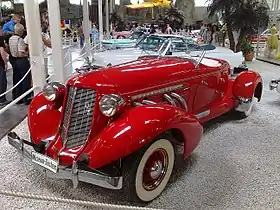Auburn Speedster
The Auburn Speedster was an American car, manufactured by the Auburn Automobile Company of Auburn, Indiana. The Auburn 851 Speedster of 1935 was styled by designer Gordon Buehrig, who also was responsible for the Cord Model 810.
| Auburn Speedster | |
|---|---|
 1935 Auburn Boattail Speedster 851 | |
| Overview | |
| Manufacturer | Auburn Automobile Company |
| Production | 1925-1937 |
| Assembly | Auburn, Indiana |
| Designer | Gordon Buehrig |
| Body and chassis | |
| Body style | 2-door speedster |
| Powertrain | |
| Engine | 4.8L side-valve Lycoming engine 6.4L V12 Lycoming |
| Transmission | Three speed manual with synchromesh on second and third ratios in 'high' |
| Dimensions | |
| Length | 4,930 mm (194 in) |
| Width | 1,800 mm (71 in) |
| Curb weight | 1,700 kg (3,700 lb) |
History
In 1924 Auburn output was down to six cars a day, Errett Lobban Cord—a successful automobile salesman—took over the distressed company, and brought in James Crawford to design and develop a new range of vehicles.
First Auburn Eight (Eight-In-Line / 8-88 / Speedster 115)
The first Auburn eight model was introduced in 1925, as the "Auburn Eight-In-Line". In the following year, it received an ungraded 4.8-liter side-valve 68 bhp Lycoming engine and was renamed "8-88".
That powertrain remained in use until 1930, when it developed 115 bhp, hence the "Speedster 115" model name. The car was of a straightforward and stout design. Suspension was by semi-elliptic springs all round,[1] and after experiments with hydraulic brakes, Auburn opted for mechanical brakes. The three-speed gearbox was in unit with the engine. The impressive open two-seater body styled by Count Alexis de Sakhnoffsky featured a boat-tail and a vee windscreen.
Speedster 125
In 1930, the Auburn Speedster was upgraded and it was renamed "Speedster 125". The Speedster 125 was advertised as a "racing car with comfort of a closed car" with a 125 bhp version of the Lycoming eight giving it a top speed of over 100 mph. It came with models such as "cabin speedster" and others.
A V12 range, using a 6.4-liter engine designed by George Kublin and built by Lycoming was rather short-lived and eventually did not prove successful, 1934 marked its demise.[1]
Speedster 851
.jpg.webp)
The "Speedster 851" would be the final production model of the manufacturer was introduced in 1931 with bodywork by Gordon Buehrig that was ingeniously constructed and cost-effectively built. Its bespoke flat-head eight was powerful, reliable and of a strong and solid design.
The sweeping body lines concealed some innovative and advanced technical features such as the Columbia dual-ratio rear axle[1] that was achieved by interposing an epicyclic gear train between the axle and the crown wheel. When it was engaged, the final drive ratio became a "fast" 4.5:1. It was disengaged by moving a steering-wheel mounted lever and dipping the clutch, whereupon the ratio became a more leisurely 3:1. The three-speed synchromesh gearbox along with that dual ratio axle gave a six-speed transmission. In 1936 came the 852, identical to the earlier models with the exception of the "852" on its radiator grille. The final year of production was 1937 as Auburn ceased car production altogether in 1937.
Evolution
- 1926: Engine size increased from 4.5 liters to 4.8 liters and the model renamed the 8-88.
- 1927: The 68 hp engine uprated to 115 hp and the car is renamed the 115.
- 1929: 120 development of 115 introduced.
- 1930: 125 introduced.
- 1934: The best known Speedster—the 851—was introduced for the 1935 model year. It uses a 4.5-liter straight-eight engine, supercharged or unblown.
- 1937: Auburn car production ceased.
Design and statistics (Speedster 851)
Engine
- Location: Front, longitudinal.
- Type: Water-cooled in-line flathead side-valve eight cylinder with aluminum alloy cylinder head.
- Cubic capacity: 4585 cc/280 cu in.
- Bore x stroke: 77.78 mm × 120.6 mm/3.06 in × 4.75 in.
- Valve gear: Two in-line valves per cylinder operated by block mounted camshaft.
- Fuel supply: Single Strombreg downdraft carburettor with Schweitzer-Cummins centrifugal supercharger.
- Ignition: Coil and distributor, mechanical.
- Maximum power: 150 bhp @ 4000 rpm[1]
Transmission
- Layout: Clutch and gearbox in unit with engine.
- Clutch: Single dry plate
- Gearbox: Three speed manual with synchromesh on second and third ratios in 'high'
- 1st 2.86:1
- 2nd 1.68:1
- 3rd 1.0:1
- Final drive: Spiral bevel with epicyclic gear dual ratio axle.[1]
- Ratio: 3:1 and 4.5:1
Suspension
- Front: Non-independent with semi-elliptic leaf springs and hydraulic dampers.
- Rear: Non-independent with live axle, semi-elliptic leaf springs and hydraulic dampers.[1]
Steering
- Type: Worm and peg.[1]
Brakes
- Type: Lockheed drums front and rear; hydraulically operated.[1]
Wheel and tires
- Type: Steel welded spoke wheels with 6.50″ × 15″[1]
Body/chassis
- Type: Steel box section X-braced chassis with steel Speedster body, two doors, two seats.[1]
Dimensions and weight
- Length: 4,930 mm (194 in)
- Width: 1,800 mm (71 in)
- Weight: 1,700 kg (3,700 lb)
Performance
- Maximum speed: 100 mph (160 km/h)
Reception and Legacy
The Speedster's iconic "boattail" design would be replicated on cars from later decades, with the two most notable examples being the 1963–1967 Chevrolet Corvette Stingray and the 1971–1973 Buick Riviera.
In select early Detective Comics' Batman comics, the Batmobile appears to be modelled after Auburn 851 Speedster.[2]
References
- Cheetham, Craig (2004). Vintage Cars: The Finest Prewar Automobiles. Rochester, United Kingdom: Grange Books. p. 31. ISBN 1840136359.
- Detective Comics #37, March 1940 - Batman: "The Screaming House"
External links
| Wikimedia Commons has media related to Auburn 851/852. |